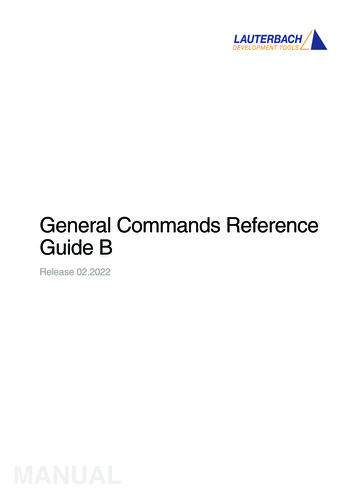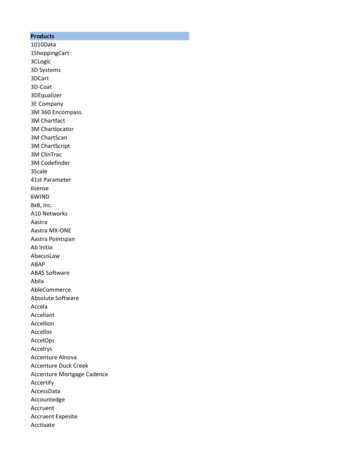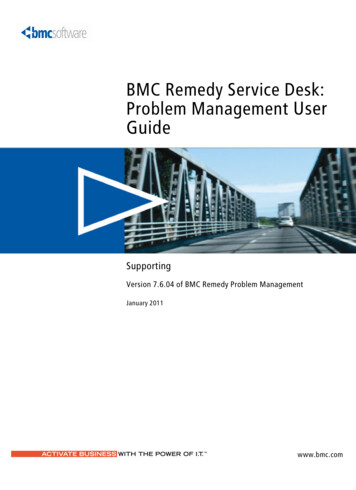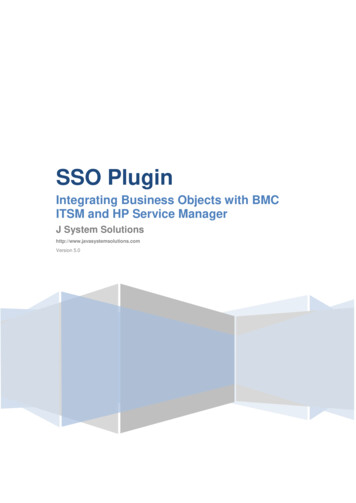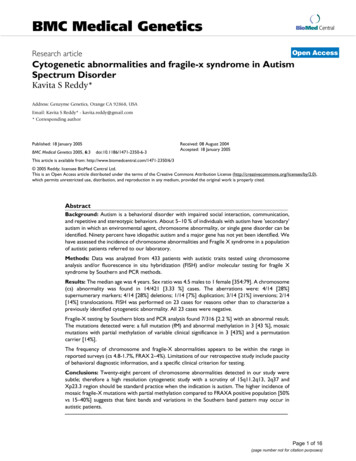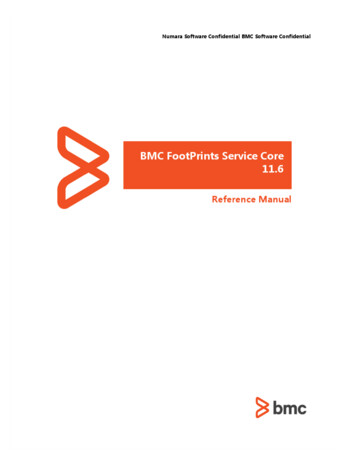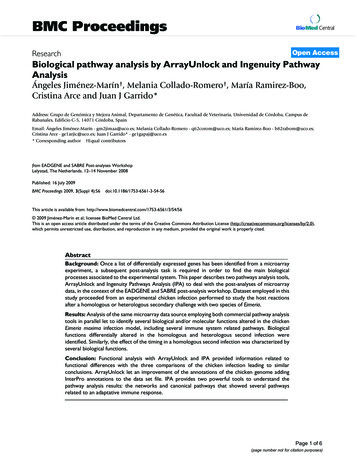
Transcription
BMC ProceedingsBioMed CentralOpen AccessResearchBiological pathway analysis by ArrayUnlock and Ingenuity PathwayAnalysisÁngeles Jiménez-Marín†, Melania Collado-Romero†, María Ramirez-Boo,Cristina Arce and Juan J Garrido*Address: Grupo de Genómica y Mejora Animal, Departamento de Genética, Facultad de Veterinaria, Universidad de Córdoba, Campus deRabanales, Edificio C-5, 14071 Córdoba, SpainEmail: Ángeles Jiménez-Marín - gm2jimaa@uco.es; Melania Collado-Romero - q62corom@uco.es; María Ramirez-Boo - b82rabom@uco.es;Cristina Arce - ge1arjic@uco.es; Juan J Garrido* - ge1gapaj@uco.es* Corresponding author †Equal contributorsfrom EADGENE and SABRE Post-analyses WorkshopLelystad, The Netherlands. 12–14 November 2008Published: 16 July 2009BMC Proceedings 2009, 3(Suppl 4):S6doi:10.1186/1753-6561-3-S4-S6 supplement title p EADGENE and SABRE Post-analyses Workshop /p /title editor Dirk-Jan de Koning /editor sponsor note The publication of these proceedings was supported by the EC-funded Network of Excellence EADGENE (EC contract number FOOD-CT-2004-506416). /note /sponsor note Proceedings /note url -3-S4-info.pdf /url /supplement This article is available from: http://www.biomedcentral.com/1753-6561/3/S4/S6 2009 Jiménez-Marín et al; licensee BioMed Central Ltd.This is an open access article distributed under the terms of the Creative Commons Attribution License (http://creativecommons.org/licenses/by/2.0),which permits unrestricted use, distribution, and reproduction in any medium, provided the original work is properly cited.AbstractBackground: Once a list of differentially expressed genes has been identified from a microarrayexperiment, a subsequent post-analysis task is required in order to find the main biologicalprocesses associated to the experimental system. This paper describes two pathways analysis tools,ArrayUnlock and Ingenuity Pathways Analysis (IPA) to deal with the post-analyses of microarraydata, in the context of the EADGENE and SABRE post-analysis workshop. Dataset employed in thisstudy proceeded from an experimental chicken infection performed to study the host reactionsafter a homologous or heterologous secondary challenge with two species of Eimeria.Results: Analysis of the same microarray data source employing both commercial pathway analysistools in parallel let to identify several biological and/or molecular functions altered in the chickenEimeria maxima infection model, including several immune system related pathways. Biologicalfunctions differentially altered in the homologous and heterologous second infection wereidentified. Similarly, the effect of the timing in a homologous second infection was characterized byseveral biological functions.Conclusion: Functional analysis with ArrayUnlock and IPA provided information related tofunctional differences with the three comparisons of the chicken infection leading to similarconclusions. ArrayUnlock let an improvement of the annotations of the chicken genome addingInterPro annotations to the data set file. IPA provides two powerful tools to understand thepathway analysis results: the networks and canonical pathways that showed several pathwaysrelated to an adaptative immune response.Page 1 of 6(page number not for citation purposes)
BMC Proceedings 2009, 3(Suppl 4):S6BackgroundMicroarray provides expression levels for thousands ofgenes simultaneously. The differentially expressed genescan be studied with different pathway analysis tools toconnect with existing biological pathways by using publicsources. Therefore, the integration of the differentiallyexpressed genes into known biological pathways is a versatile tool for understand the biological complexity ofgene expression. The EADGENE and SABRE post-analysisworkshop evaluated different methods and software todeal with the post-analysis of microarray data [1]. In thisstudy the analysis tools employed were Array Unlock anIPA and the data set used comes from microarrays assaysperformed to characterize the gene expression profile aftera homologous or heterologous challenge of broilersprimed with Eimeria maxima as summarised in [1].MethodsMicroarray datasetThe microarray employed in this study was the Arkgenomics chicken 20 K oligo microarray prepared from20,460 oligonucleotides designed against the chickenENSEMBL transcripts [2].ExperimentTwo weeks old chicken infected with Eimeria maxima werechallenged two weeks later with Eimeria maxima (MM),Eimeria acervulina (MA), or PBS (PM). The samples werecollected at 8 hours (MM8, MA8, PM8) and 24 (MM24)hours after infection. The analysis performed allow us toobtain information about: i) differences among a homologous second infection or a heterologous one withanother specie of Eimeria (MM8 MA8); ii) how changesthe response along the time after a second homologousimmunization (MM8 MM24); and iii) the secondaryimmune response (MM8 PM8) [1].Working fileThe three lists of genes differentially expressed were previously filtered by an adjusted p-value 0.05. Three working files were generated to perform both analyses usingthe three datasets. These files must contain one columnincluding all gene ID annotations identified by the twobioinformatics tools. This column was generated according to the annotations provided in the annotation file:original gene IDs (Unigene, HGNC) and mapped withhuman, mouse and rat homolog. Additional file 1 contains the 'working files' for the three comparisons.ArrayUnlock softwareArrayUnlock (Integromics S.L., Spain) [3] was used toexplore the main biological processes associated tochicken infection employing the 'Biological Enrichment'functionality. This functionality is able to find those biological annotations that are highly associated to a list nes differentially expressed. Selected annotations wereGO Biological Process, GO Molecular Function, GO Cellular Component KEGG pathways and INTERPRO motifs.Annotation associations were filtered by a p-value 0.01.Ingenuity Pathways AnalysisThe ''Core Analysis' function included in IPA (IngenuitySystem Inc, USA) [4] was used to interpret the chickendata in the context of biological processes, pathways andnetworks. All Identifier Types were selected since morethan one type of identifier exists in our dataset (workingfile). Both up- and down-regulated identifiers weredefined as value parameters for the analysis. After theanalysis, generated networks are ordered by a score meaning significance. On the other side, significance of the biofunctions and the canonical pathways were tested by theFisher Exact test p-value. Biofunctions were grouped in:Disease and Disorders; Molecular and Cellular Functions;and, Physiological System Development and Function. Ina similar way canonical pathways were grouped in Metabolic Pathways and Signaling Pathways. Canonical pathways can also been ordered by the ratio value (number ofmolecules in a given pathway that meet cut criteria,divided by total number of molecules that make up thatpathway). In contrast to ArrayUnlock, this pathway analysis tool generates networks where the differentially regulated genes can be related according to previously knownassociations between genes or proteins, but independently of established canonical pathways. Moreover, networks are associated to functions according to themolecules involves.ResultsFunctional analysis and biological enrichment byArrayUnlockFunctional analysis results using ArrayUnlock identifiedsignificant biological functions altered differentially inthe three comparisons analyzed. For each of the biologicalannotations groups an Excel file was generated includingthe complete information obtained for each comparison(See Additional files 2, 3, 4, 5, 6). Interestingly, this pathway analysis tool let us 'enrich' gene annotations withInterpro motifs annotations. Results were also visualizedas pie and horizontal-bar charts including the 20 most significant associated biological functions (results notshown, see Additional file 7 as an example). A summaryof pie and horizontal-bar charts information is presentedin Tables 1 and 2 for Biological Processes and KEGG pathways ordered by significance and number of implicatedgenes. The low number of genes significantly associated tothis functions in the comparison MM8 MA8 (most ofthem among 1 and 4 genes) denotes low differencesamong a homologous and a heterologous second immunization. However, a higher number of differentiallyexpressed genes where associated to biological functionsPage 2 of 6(page number not for citation purposes)
BMC Proceedings 2009, 3(Suppl 6Table 1: Top ten Biological Processes significantly altered in ArrayUnlock analysis. In brackets, number of genes from the input fileimplicated in each annotation. Significance at p 0.05.Biological ProcessMM8 MA8MM8 MM24- Regulation of transcription DNA-dependent (5)- Metabolic process (4)- Cell adhesion (4)- Transcription (4)- Actin cytoskeleton organization and biogenesis(4)- Cytoskeleton organization and biogenesis (2)- Chromatin modification (2)- Small GTPase mediated signal transduction (2)-Integrin-mediated signalling pathway (2)-Cation transport (2)MM8 PM8- Signal transduction (34)- Transcription (24)- Signal transduction (84)- Regulation of transcription, DNA-dependent(71)- Cell adhesion (19)-Transcription (65)-Multicellular organismal development (18) - Multicellular organismal development (44)- Ion transport (15)- Cell cycle (34)- Protein amino acid phosphorylation (13)- Cell differentiation (12)- Nervous system development (12)- Cell cycle (12)- Protein transport (11)in comparison MM8 MM24, showing a clear differentresponse to a homologous second immunization associated to the time. On the other hand, the results obtainedin MM8 PM8 for KEGG (Table 2) show pathways differentially altered among a primary and a secondaryimmune response. Most of these pathways were nopresent in the other two comparisons which shows that inboth MA8 and MM24 such a typical secondary responsewas developed as in MM8.Functional analysis by IPAIPA identified significant networks, top functions andcanonical pathways associated with the differentiallyexpressed genes for each comparison analyzed (see Additional file 8). The first networks scored for theMM8 MM24 and MM8 PM8 comparisons are presentedin Additional file 9. A similar result to that obtained withArrayUnlock was obtained for the comparisonMM8 MA8, a lower number of genes significantly associated to biological functions (a maximum of five genes per- Protein transport (33)- Metabolic process (30)- Apoptosis (29)- Cell adhesion (28)- Protein amino acid phosphorylation (28)function) compared with the other two comparisons.Similarly, in this comparison, only five canonical pathways were significant. In the comparison MM8 MM24seven out of the ten most significant canonical pathwayswere related to cellular signalling, e.g.: cAMP signalling;integrin signalling; actin cytoskeleton mediated signalling; and G-coupled receptor signaling. Interestingly, inthis comparison the functions more significant and withhigher number of genes implicated correspond to 'cellmorphology', 'cellular assembly and organization', and'cellular development' being most genes down-regulated.In the comparison MM8 PM8 the 'immune response' and'immune and lymphatic system development and function' are among the most significant functions altered.Then, most genes related to proliferation and maturationof B lymphocytes, recruitment of macrophages and antigen presenting cells, increasing of NK cells and T-cellswere up-regulated. As an example, the T cell receptor signalling canonical pathway obtained by IPA and associatedTable 2: Top ten KEGG Pathways significantly altered in ArrayUnlock analysis. In brackets, number of genes from the input fileimplicated in each annotation. Significance at p 0.05.KEGG PathwaysMM8 MA8- GnRH signalling (1)- Regulation of actin cytoskeleton (1)- Long-term potentiation (1)- Leukocyte transendothelial migration (1)- Focal adhesion (1)- Ubiquitin mediated proteolysis (1)- MAPK signalling pathway(1)- Glycan structures-degradation (1)- Glycan structures-biosynthesis 2 (1)- Glycan structures-biosynthesis 1 (1)MM8 MM24- MAPK signalling pathway (13)-Neuroactive ligand-receptor interaction (10)- Regulation of actin cytoskeleton (8)- Focal adhesion (8)- GnRH signalling pathway (6)- Axon guidance (6)- Calcium signalling pathway (6)- Pancreatic cancer (4)- Long-term potentiation (4)-Leukocyte transendothelial migration (4)MM8 PM8- Focal adhesion (22)- MAPK signalling pathway (21)-Jak-STAT signalling pathway (16)- Cytokine-cytokine receptor interaction (16)- Cell cycle (14)- Fc epsilon RI signalling pathway (11)- Natural killer cell mediated cytotoxicity (11)- Insulin signalling pathway (10)- Apoptosis (10)- T cell receptor signalling pathway (9)Page 3 of 6(page number not for citation purposes)
BMC Proceedings 2009, 3(Suppl 4):S6with the differentially expressed genes for the comparisonMM8 PM8 is shown Figure 1.ConclusionThe results of the analysis were highly dependent of having the most complete annotation available in the data setfile. According to this, the creation of the 'working file'was critical in order to take the maximum advantage ofthe analysis what can be considered as a drawback of /S4/S6Both tools provided, information for a global understanding of the underlying biological processes, independently.First, homologous and heterologous second infectioninduces similar changes in gene expression, althoughsome differences were found associated to several biological functions. Second, the response upon a secondhomologous infection varied with the time and differedsignificantly in a relative high number of biological functions. And third, a core of biological functions and pathways associated to a secondary response were similarwhen the second challenge varied in the time and also inthe case of a heterologous secondary infection.FigureTcell receptor1signalling canonical pathway obtained by IPA obtained in comparison MM8 PM8T cell receptor signalling canonical pathway obtained by IPA obtained in comparison MM8 PM8. Up- and downregulated genes in red and green, respectively.Page 4 of 6(page number not for citation purposes)
BMC Proceedings 2009, 3(Suppl 4):S6The two analytical tools provided overlapping information so as complementary information. Main differenceswere due to databases used for each tool. UrrayUnlockresults are based in gene ontology terms or KEGG annotations widely known and used in other analytical tools andable to be consulted in free-access databases. On the otherside, IPA makes use of a non public bibliographic database and own terminology for functions classification thatnot always are directly correlated with GO terms. Anadvantage of Ingenuity was that this tool classify the genesimplicated in each function within sub-functions and provide direct link of each molecule to the bibliographic reference were that relationship is described. The resultsobtained for both tool to identify altered establishedpathways (canonical pathways in IPA and KEGG pathways in ArrayUnlock) were similar, however, IPA integrates the information of the differentially expressedgenes within the figures highlighting the up or down regulation. In general, IPA provided a better presentation ofthe results and an easier identification of molecules implicated in each function within the interface of the software.Moreover, IPA generates networks where the differentiallyregulated genes can be related according to previouslyknown associations between genes or proteins, but independently of established canonical pathways.Competing interestsThe authors declare that they have no competing interests.Authors' contributionsMRB learned the management of the two tools andtrained to the rest member's group. The comparisons wereanalyzed by MRB, CA, MCR and AJM. AJM conducted thedocumentation and communication related to the workshop to the other group members. JJG coordinated andsupervised the working 6Additional file 3ArrayUnlock Molecular Functions. File contains information about: biological function annotation; p-Value and corrected p-Value; number ofgenes of our list implicated in each annotation; number of gene from theArrayUnlock database implicated in this annotation; and finally, adescription of each GO biological function annotation.Click here for ntary/17536561-3-S4-S6-S3.xls]Additional file 4ArrayUnlock Cellular Components. File contains information about:biological function annotation; p-Value and corrected p-Value; number ofgenes of our list implicated in each annotation; number of gene from theArrayUnlock database implicated in this annotation; and finally, adescription of each GO biological function annotation.Click here for ntary/17536561-3-S4-S6-S4.xls]Additional file 5ArrayUnlock KEGG Pathways. File contains information about: biological function annotation; p-Value and corrected p-Value; number of genesof our list implicated in each annotation; number of gene from the ArrayUnlock database implicated in this annotation; and finally, a descriptionof each GO biological function annotation.Click here for ntary/17536561-3-S4-S6-S5.xls]Additional file 6ArrayUnlock INTERPROMotifs. File contains information about: biological function annotation; p-Value and corrected p-Value; number ofgenes of our list implicated in each annotation; number of gene from theArrayUnlock database implicated in this annotation; and finally, adescription of each GO biological function annotation.Click here for ntary/17536561-3-S4-S6-S6.xls]Additional file 7Additional materialAdditional file 1Working files. Gene annotation, fold-change, and the identifier of theoriginal data are shown.Click here for ntary/17536561-3-S4-S6-S1.xls]Additional file 2ArrayUnlock Biological Process. File contains information about: biological function annotation; p-value and corrected p-value; number of genesof our list implicated in each annotation; number of gene from the ArrayUnlock database implicated in this annotation; and finally, a descriptionof each GO biological function annotation.Click here for ntary/17536561-3-S4-S6-S2.xls]Graphical representation as horizontal-bar (A) and pie chart (B) of theresults obtained for Biological Process using ArrayUnlock software for thecomparison MM8 PM8.Click here for ntary/17536561-3-S4-S6-S7.doc]Additional file 8IPA top Networks, BioFunctions and Canonical Pathways for the threecomparisons analyzed.Click here for ntary/17536561-3-S4-S6-S8.xls]Additional file 9The first network identified by IPA analysis for MM8 MM24 and MM8PM8 analysis.Click here for ntary/17536561-3-S4-S6-S9.doc]Page 5 of 6(page number not for citation purposes)
BMC Proceedings 2009, 3(Suppl 6AcknowledgementsAuthors are grateful to anonymous reviewers and editor for their comments and suggestions. Acknowledgement to EADGENE and SABRE forfinance the workshop. To ASG-Lelystad for host the workshop meeting.Caroline Channing and Sandrine Ayuso for the organization. AnnemarieRebel and colleagues to offer their data set for the analysis.This article has been published as part of BMC Proceedings Volume 3 Supplement 4, 2009: EADGENE and SABRE Post-analyses Workshop. The fullcontents of the supplement are available online at http://www.biomedcentral.com/1753-6561/3?issue S4.References1.2.3.4.Hedegaard J, Arce C, Bicciato S, Bonnet A, Ramerez-Boo M, Buitenhuis AJ, Collado-Romero M, Conley LN, SanCristobal M, Ferrari F, etal.: Methods for interpreting lists of affected genes obtainedin a DNA microarray experiment. BMC Proceedings 2009,3(Suppl pecies/chicken/].ArrayUnlock software web link ity Pathways Analysis software web link[http://www.ingenuity.com/]Publish with Bio Med Central and everyscientist can read your work free of charge"BioMed Central will be the most significant development fordisseminating the results of biomedical researc h in our lifetime."Sir Paul Nurse, Cancer Research UKYour research papers will be:available free of charge to the entire biomedical communitypeer reviewed and published immediately upon acceptancecited in PubMed and archived on PubMed Centralyours — you keep the copyrightBioMedcentralSubmit your manuscript here:http://www.biomedcentral.com/info/publishing adv.aspPage 6 of 6(page number not for citation purposes)
BioMed Central Page 1 of 6 (page number not for citation purposes) BMC Proceedings Research Open Access Biological pathway analysis by ArrayUnlock and Ingenuity Pathway Analysis Ángeles Jiménez-Marín †, Melania Collado-Romero , María Ramirez-Boo, Cristina Arce and Juan J Garrido*
